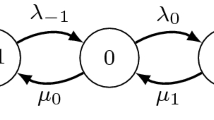Abstract
For a birth and death chain on the nonnegative integers with birth and death probabilities p i and q i≡ 1 –p i and reflecting barrier at 0, it is shown that the right tails of the probability of the first return from state 0 to state 0 are simple transition probabilities of a dual birth and death chain obtained by switching p iand q i. Combinatorial and analytical proofs are presented. Extensions and relations to other concepts of duality in the literature are discussed.
Similar content being viewed by others
REFERENCES
Chihara, T. S. (1990). The parameters of a chain sequence. Proc. Amer. Math. Soc. 108:775–780.
Clifford, P., and Sudbury, A. (1985). A sample path proof of the duality for stochastically monotone Markov processes. Ann. of Prob. 13:558–565.
Cox, J. T., and Rösler, U. (1984). A duality relation for entrance and exit laws for Markov processes. Stoch. Proc. and their Appl. 16:141–156.
Daley, D. J. (1968). Stochastically monotone Markov chains. Z. Wahrsch. Verw. Gebiete 10:305–317.
Dette, H., and Studden, W. J. The Theory of Canonical Moments with Applications in Statistics, Probability and Analysis. John Wiley (in press).
Diaconis, P., and Fill, J. A. (1990). Strong stationary times via a new form of duality. Ann. Prob. 18:1483–1522.
Feller, W. (1967). An Introduction to Probability Theory and Its Applications, Vol. 1, Third edition, John Wiley.
Flajolet, P. (1980). Combinatorial aspects of continued fractions. Discrete Math. 32:125–162.
Gerl, P. (1984). Continued fraction methods for random walks on N and on trees. In Probability Methods on Groups, Proceedings, Oberwolfach 1983, Vol. 1064 of Springer Lecture Notes in Mathematics, Springer-Verlag, Berlin, pp. 131–146.
Good, I. J. (1958). Random motion and analytic continued fractions. Proc. Camb. Phil. Soc. 54:43–47.
Jansons, K. M. (1996). Excursions into a new duality relation for diffusion processes. Electronic Communications in Probability, Vol. 1, Paper 7.
Jones, W. B., and Magnus, A. (1977). Applications of Stieltjes fractions to birth-death processes. In Saff, E. B., and Varga, R. S. (eds.), Padé and Rational Approximation, pp. 173–179. Academic Press, New York.
Jones, W. B., and Thron, W. J. (1980). Continued Fractions: Analytic Theory and Applications, Vol. 11 of Encyc. of Math. and Appl., Addison-Wesley.
Karlin, S., and McGregor, J. (1957). The classification of birth and death processes. Trans. Amer. Math. Soc. 86:366–400.
Knight, F. B. (1981). Characterization of the Lévy measure of inverse local times of gap diffusions. Birkhäuser, Boston. Seminar on Stochastic Processes, 1981, pp. 53–78.
Küchler, U. (1987). On Itô's excursion law, local times and spectral measures for quasidiffusions. In Prohorov, Yu. V., Statulevicius, V. A., Sazanov, V. V., Grigelionis, B. (eds.), Probability Theory and Mathematical Statistics, Vol. 2, pp. 161–165. VNU Science Press, Netherlands.
Lau, T. S. (1983). Theory of canonical moments and its applications in polynomial regression I and II. Technical Reports 83–23 and 83–24, Department of Statistics, Purdue University.
Liggett, T. (1985). Interacting Particle Systems. Springer-Verlag.
Murphy, J. A., and O'Donohoe, M. R. (1975). Some properties of continued fractions with applications to Markov processes. J. Inst. Math. Applics. 16:57–71.
Perron, O. (1954). Die Lehre von den Kettenbrüchen I. Teubner Verlag, Stuttgart.
Rogers, L. C. G., and Pitman, J. (1981). Markov functions. Ann. Prob. 9:573–582.
Ross, S. M. (1983). Stochastic Processes. John Wiley.
Siegmund, D. (1976). The equivalence of absorbing and reflecting barrier problems for stochastically monotone Markov processes. Ann. Prob. 4:914–924.
Skibinsky, M. (1986). Principal representations and canonical moment sequences for distributions on an interval. J. Math. Anal. Appl. 120:95–120.
Wall, H. S. (1940). Continued fractions and totally monotone sequences. Trans. Amer. Math. Soc. 48:165–184.
Wall, H. S. (1948). Analytic Theory of Continued Fractions. Van Nostrand.
Author information
Authors and Affiliations
Rights and permissions
About this article
Cite this article
Dette, H., Fill, J.A., Pitman, J. et al. Wall and Siegmund Duality Relations for Birth and Death Chains with Reflecting Barrier. Journal of Theoretical Probability 10, 349–374 (1997). https://doi.org/10.1023/A:1022660400024
Issue Date:
DOI: https://doi.org/10.1023/A:1022660400024



